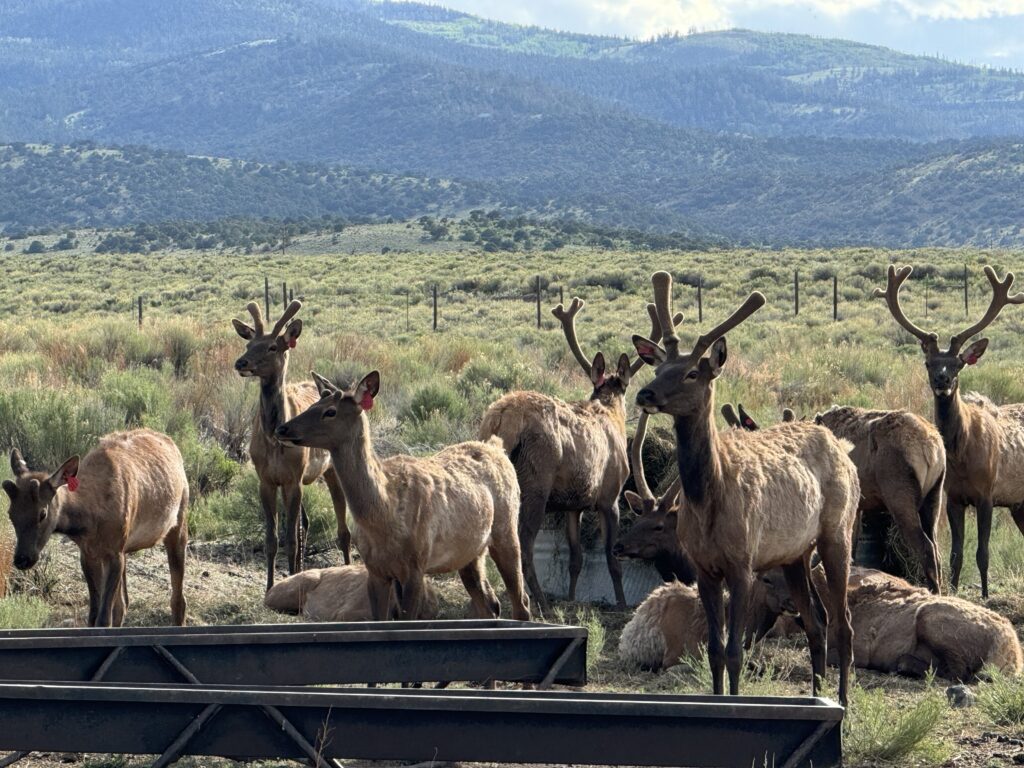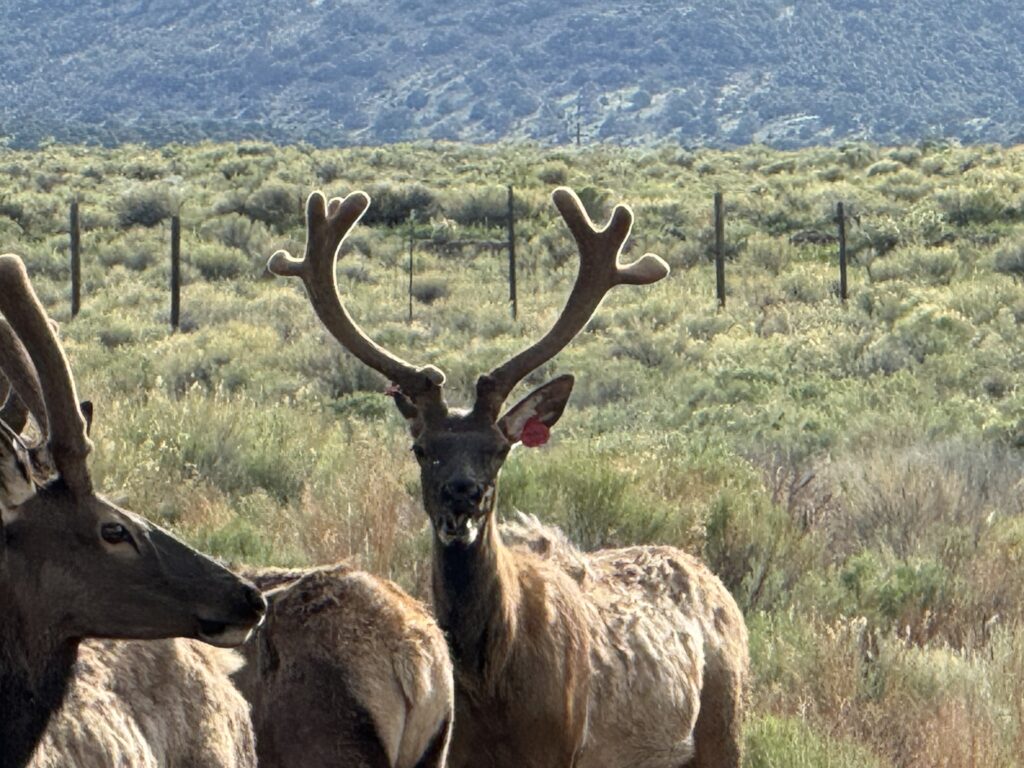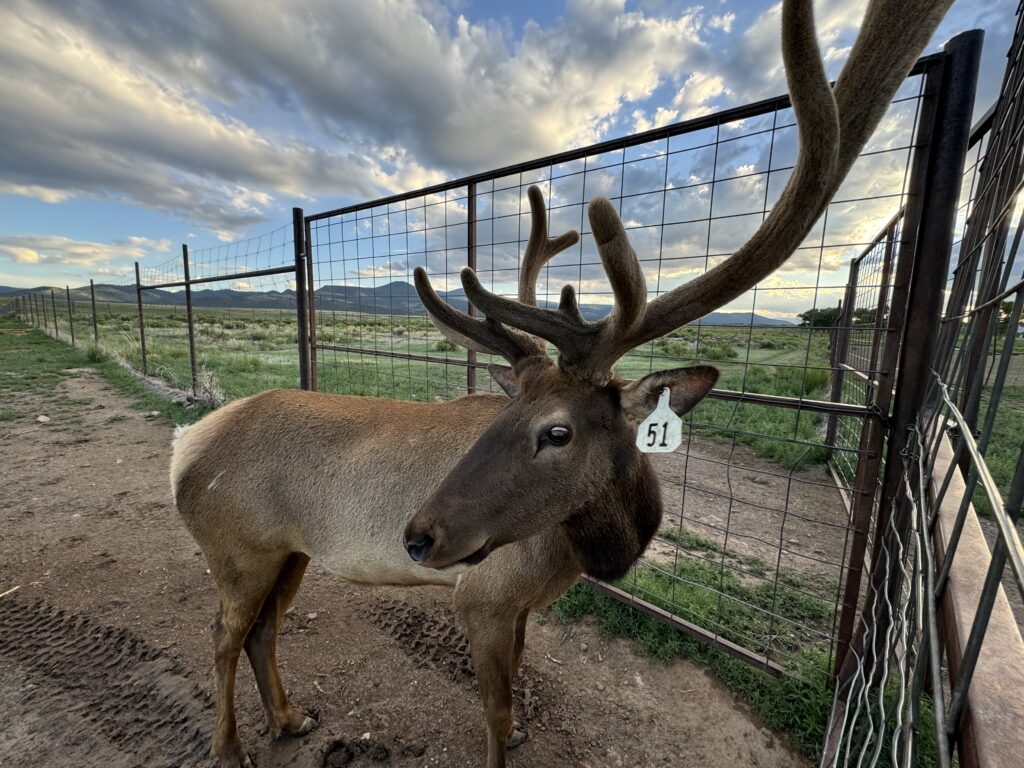Elk are considered old world deer whose ancestors have been found on European and Asian Continents. They are thought to have migrated across the Bering Strait land bridge 10,000 to 12,000 years ago. Many scientists believe that the elk’s ivory teeth are the remnants of tusks from the elk’s prehistoric ancestors and that they used to be 6-8” long.
Elk are one of the few creatures that possess both antlers and canine teeth, also called “ivories”, “buglers” and “whistlers”. These teeth are located on the upper jaw near the front of the mouth. Elk are the only North American animal, aside from the walrus, that have ivory canines.
Elk easily adapt to a wide range of temperatures by growing two entirely different coats. The summer coat is a thin, sleek layer of short hair that is the color of copper. It is entirely replaced by the light brown and tan winter coat, which consists of two layers – thick, long guard hairs and a dense, wooly undercoat.
During the winter, elk feed on open sunny slopes and bed down in the trees at night to seek shelter from wind and cold temperatures.
During the summer, elk bed down in cool, shady forests during the day and wade or lie in streams, rivers, ponds and lakes to seek relief from heat and biting insects.
Elk and other members of the deer family belong to a group of animals called ungulates, the Latin word for “hoof.” All ungulates have hooves. There are two distinct orders of “ungulates”. The number of toes is the most obvious difference between the orders. Artiodactyls (elk, deer, bison, pronghorn, peccary) have an even number of toes and the males grow and shed their antlers each year. Perissodactyls (horses, elephants) have an odd number of toes. Ungulates are herbivores — they eat only plants. Their diet may include grasses, forbs (low-growing, short-stemmed plants), shrubs and trees (including limbs and bark).
Elk are also called wapiti, a Native American word that means “light-colored deer.”
When an elk receives a signal of danger, it raises its head high and opens its eyes widely. It rotates the ears and tries to capture the sound.
Bulls
Bulls reach maturity at 7 to 8 years of age. A mature bull averages 800 to 1,100 pounds, stands 5’ to 5’6” at the shoulder and 8’ from nose to tail.
Bulls are capable of breeding at two years of age.
Due to the increasing daylight, Bulls lose their antlers in March and April and regrow them every year. Bulls grow antlers back in 90 days and can grow upwards of 2” a day during peak times. If a human could grow bone that quickly, a broken leg would heal in one day.
Bulls remain infertile for two or three months during velvet antler growth.
The number of antler points and antler mass on a bull are influenced by genetics and feed, as well as by maturity. A set of antlers can weigh more than 40 pounds.
After the summer solstice, bulls’ testosterone levels increase and begin the calcification of the velvet antler. Bulls begin stripping the velvet covering in August. The reproduction patterns of elk are prompted by an increase in melatonin as night lengths increase.
The rut begins in late August and continues through October.
During the rut, the neck muscles and body mass of the bulls increase. A thick mane develops and the voice box enlarges to allow bugling.
Bulls compete for dominance through bugling, sparring, and chasing would-be competitors away (injuries are rare).
Bulls also create and seek out wet areas to mark territory by wallowing and scenting.
A bull will gather a group of females and keep then away from other bulls. One bull can service 20 to 40 cows.
Bulls and cows go through a ritual before the actual “high mount” of mating.
During the rut, a bull elk can loose up to 30% of his weight.
After the rut, bulls slowly lose much of their aggression and dominant activity, are at their lowest weight, and are in a most vulnerable physical condition with no fat reserves.
A bull will dress out at approximately 60% of live weight.
Cows
Elk Cows are considered mature at 3-4 years of age. At maturity, they average 550 to 600 pounds, stand 4’ to 5’ at the shoulder, and are approximately 61/2’ from nose to tail.
Young cows usually come into estrus at 18-months of age.
Cows do not grow antlers.
As with bulls, a cow’s estrus cycle is prompted by an increase in melatonin as night lengths increase in late summer and early fall.
Artificial insemination is common in elk ranching, with a success rate of 50-80%.
A cow’s gestation is approximately 246 days, plus or minus 10.
Elk are a single offspring species; twinning is rare.
Elk cows are very good mothers. Bonding between mother and calf begins when the cow labels her own calf with her saliva when cleaning the calf after birth. The calf call, or squeal, and the response from the mother, also plays an important role in the bonding process.
Calves
Calves are born in May through June and spend the first week of their lives in tall grass, usually getting up only to nurse.
A newborn calf can stand within 30-45 minutes. Calves weigh around 40 pounds at birth and grow about a pound and a half a day.
Calves are spotted and scentless when born to help hide and protect them from predators. They develop their brown coats in six months.
Through natural instinct, the cow watches the calf from a short distance, drawing near when it is threatened.
Elk Meat
Elk meat, or venison, has fewer calories, less fat, and less cholesterol than beef, chicken, lamb, turkey and most fish. Elk meat is also very high in protein and is more richly flavored than beef. It is also rich in minerals particularly iron and phosphorus, which accounts for its rich dark coloring.
Elk are raised using no growth hormones or chemicals.
Elk are predominantly grazers and eat most upland grasses (e.g. broom) and legumes (e.g. alfalfa). They will also consume grains (e.g. corn, oats). Elk can consume up to 20% of their diet in browse.
Elk are efficient converters of food. Three cow elks’ feed intake is the same as that of one beef cow.
Velvet Antler
“Velvet antler” does not refer to the velvety “skin” on growing antlers but rather the whole cartilaginous antler in a pre-calcified stage.
Typically the antler is cut off near the base after it is about two-thirds of its potential full size, and before any significant calcification occurs. The antler is dried and is used in capsule form (in the U.S.) for a wide variety of health remedy and health maintenance purposes.
Velvet antler is effective as an anti-inflammatory, anti-cancer, immune stimulant, and pro-grown agent. Antlers are said to be the fastest growing membrane known, and it is this rapidly growing tissue that contains the micronutrients needed to improve some human health deficiencies.
The cutting of the velvet antlers does not harm the animal and antlers are regown the next year.
Bulls produce velvet every year. An average 2-year old will grow approximately 9 pound of velvet. Generally, bulls increase velvet yields every year until maturity. Mature bulls (7 to 8 years old) may produce 30-40 pounds of velvet.


